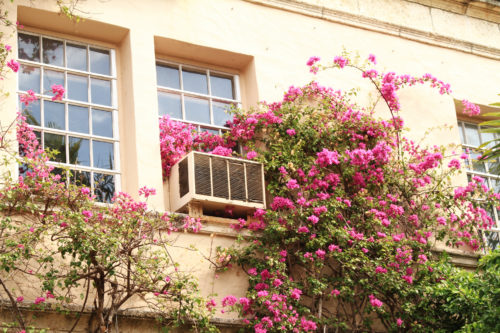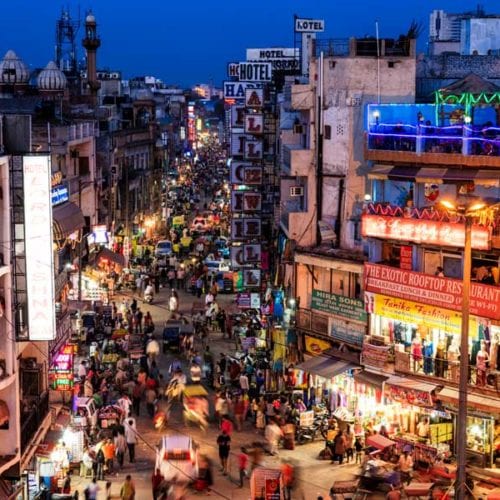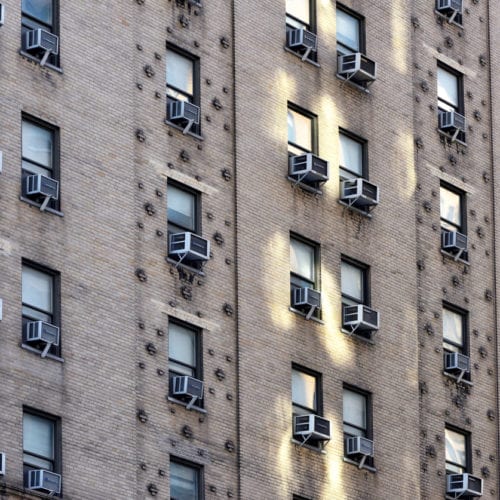"Heavy bougainvillea vines are climbing up a wall with a profusion of pink blooms, making even an old window airconditioning unit appear attractive. This tropical plant is a favorite in southern locales where they provide abundant color. Older established vines can cover a two story building when allowed to grow unchecked. These plants were found on buildings on Worth Ave in Palm Beach, Florida."

Solutions for India’s Cooling Quandary
Last month consumers across India received a jolt when they were delivered their electricity bills. The combined effects of stay-at-home measures to contain the COVID-19 pandemic, the sweltering heat of the Indian summer, and increased usage of energy intensive appliances such as air conditioners resulted in electricity bills being up to ten times higher than normal.
While electricity providers explained that the astronomical bills included adjustments against previous months’ estimated consumption, at a time when many were facing hardships due to pay cuts and unemployment, this was an added and unexpected financial stress.
Until recently, monthly utility charges were manageable for most households. India’s electricity rates are some of the lowest in the world and per capita consumption has also been low. But as economic prosperity has reached more citizens, aspirational purchases such as air conditioners have increased significantly and now more than 40 million units are in operation throughout the country.
And while air conditioners may be viewed as luxury items that offer thermal comfort while we work and study, they also save lives during increasingly common and deadly heatwaves. In a country such as India, where temperatures are known to regularly cross 110℉ (43℃) during the summer, access to cooling is increasingly a necessity. However, the stark reality is that air conditioning is incredibly harmful for the planet—not only because of the energy the units consume, but also because of the hydrofluorocarbon-based refrigerants they release into the atmosphere.
Recently, the United Nations Environment Program and the International Energy Agency released a report which goes as far as to state that the prosperity of the world and human civilization depends on access to cooling but a growing demand for cooling will be one of the most significant drivers of climate change. Analyses by top research organizations reveal that the exponential boom in demand for cooling over the next few decades is expected to cause up to 0.5C degree rise in global temperatures by the end of the century. In a nutshell, as we blast cool our homes, we are effectively roasting the planet.
India lays at the epicenter of this problem. A vast majority of its population lives in heat-stressed areas and they are projected to switch on over 1 billion room air conditioners by 2050. According to the IEA and UN report, India’s cooling demand is expected to drive an additional 800 GW of power generation. To put this into perspective, this would be more than twice the capacity in India today.
Solutions Exist
Having identified this looming concern, India has displayed foresight and leadership in addressing the problem. In 2019, the Government laid out its ground-breaking India Cooling Action Plan (ICAP), which provides a roadmap for addressing the nation’s future thermal comfort and the cooling needs in a sustainable manner through promoting and developing efficient cooling technologies.
In addition, India’s Bureau of Energy Efficiency (BEE) has been diligent and ambitious in setting minimum energy performance standards (MEPS) and star ratings for air conditioning units sold in the country, re-evaluating and setting new benchmarks every two years. This year BEE has again ratcheted up the MEPS to an ISEER of 3.1 for split-type ACs and of 2.5 for window ACs. And while their efforts are showing results, they are not enough. The bar must be raised higher.
The fact is that there are vastly better technologies available. Certain models of air conditioners already operate at double the MEPS level and about 40 percent higher efficiency compared to the 5-star label (ISEER 4.5). In addition, even more impressive technologies with the potential to have five times less climate impact have been identified by the Global Cooling Prize and could be in the market within a few years.
The Government of India and Energy Efficiency Services Limited (EESL) have also implemented bulk procurement of 50,000 energy efficient air conditioners that are 20 percent more efficient than BEE 5-star ACs but are priced comparable to BEE 3-star ACs. This effectively demonstrates what other countries have seen: that scaling demand for more efficient units brings down prices. We could expect to see the same dynamic if MEPS were raised to, or even higher than, today’s 5-star units. Making the highest-efficiency units more affordable to buy in addition to being dramatically more affordable to operate would be a huge win for consumers.
As we look ahead at what is called the Decade of Action on climate, biodiversity and the UN’s sustainable development goals, it is clear that there is literally no time to waste. We cannot wait for industry and policy to align gradually; it must be done keeping in mind the urgency of the situation. Innovation and technology advancements mean that the targets set by the world to ensure a habitable and equitable future are achievable, but strong policy support is also needed.
Taking bold steps on ensuring efficient and sustainable cooling would provide a lifeline for the climate, along with India’s energy-security ambitions. In addition, consumers would benefit immensely due to lower life cycle costs of these much-needed appliances, which would enable them to keep their air conditioners on during future unknown shocks such as pandemics and heatwaves. India can keep cool without cooking the climate, and it must.

